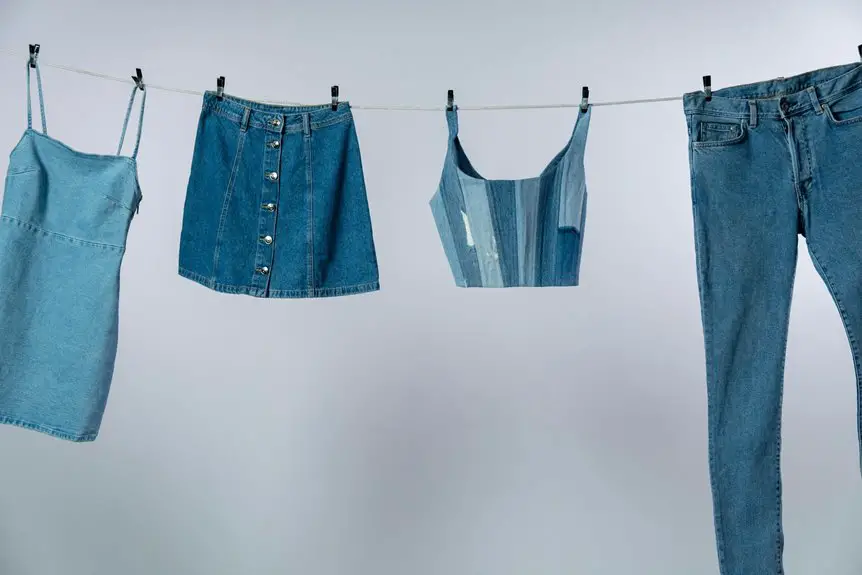Imagine you’re caught in a sudden downpour during a hike, and your cotton shirt clings to your skin for hours. You might wonder which fabrics could’ve kept you dry and comfortable instead. Understanding the drying times of various materials can help you make better choices for your outdoor adventures. So, which fabrics dry the fastest after getting soaked? Let’s explore the options.
Table of Contents
Key Takeaways
- Polyester dries the fastest, typically in as little as one hour after getting soaked.
- Nylon follows, taking around two hours to dry completely.
- Cotton can take several hours, often up to six, due to moisture retention.
- Wool has the slowest drying time because it retains moisture effectively.
- Choosing synthetic fabrics like polyester and nylon enhances quick-drying performance for outdoor activities.
Overview of Quick-Drying Fabrics
Quick-drying fabrics are essential for anyone who enjoys outdoor activities or needs reliable clothing for everyday use.
These materials are designed to wick moisture away from your skin, allowing sweat or rain to evaporate quickly. You’ll find that fabrics like polyester, nylon, and certain blends excel in this area.
Quick-drying fabrics like polyester and nylon efficiently wick moisture away, keeping you comfortable during any activity.
They’re lightweight, breathable, and often treated with water-repellent finishes, making them perfect for hiking, running, or casual wear.
When you’re caught in a sudden downpour or sweating it out during a workout, quick-drying fabrics help you stay comfortable and dry.
Plus, they’re often easy to care for, allowing you to wash and wear them without worrying about long drying times.
Your adventures deserve clothing that keeps up with you!
Fabric Drying Times Comparison
When you’re choosing clothing for outdoor adventures or workouts, understanding how different fabrics dry can make a big difference in your comfort.
Quick-drying fabrics like polyester and nylon typically dry faster than cotton or wool. If you find yourself soaked, polyester can dry in as little as one hour, while nylon may take a bit longer, around two hours.
In contrast, cotton could take several hours, sometimes up to six, depending on humidity and temperature. Wool is often the slowest, taking even longer due to its moisture retention properties.
Knowing these drying times helps you select the right gear, ensuring you stay comfortable and dry during your activities. Choose wisely, and you’ll enjoy your adventures more!
Properties of Different Fabrics
While exploring your fabric options, it’s essential to understand the unique properties each one offers.
Natural fibers like cotton and wool are breathable and comfortable but tend to hold moisture, leading to longer drying times. On the other hand, synthetic fabrics like polyester and nylon are lightweight and quick-drying, making them ideal for active wear.
Linen, a natural option, has excellent moisture-wicking abilities and dries faster than cotton, but it wrinkles easily. Rayon is soft and breathable but can absorb water, slowing its drying time.
Finally, blends can combine the best properties of different fabrics, offering versatility. By knowing these characteristics, you can make informed choices that suit your needs and preferences.
Suitability for Various Activities
Choosing the right fabric can greatly impact your experience during various activities. When you’re out and about, the fabric you choose can make all the difference in comfort and performance.
The fabric you choose plays a crucial role in enhancing your comfort and performance during outdoor activities.
Here are three activities where fast-drying fabrics shine:
- Hiking: Lightweight polyester or nylon wick away moisture, keeping you dry and comfortable on the trails.
- Swimming: Quick-drying materials like spandex or lycra allow you to switch from water to land without feeling weighed down.
- Running: Breathable fabrics such as merino wool or specialized synthetics help regulate temperature and dry rapidly, so you stay focused on your pace.
Environmental Impact of Fabrics
As you consider fast-drying fabrics, it is crucial to recognize their environmental impact. The production of synthetic materials often involves harmful chemicals and high energy consumption. Natural fibers like cotton, while biodegradable, require significant water and pesticides. Choosing the right fabric can reduce your ecological footprint.
Here’s a quick comparison of fabric types:
| Fabric Type | Environmental Impact |
|---|---|
| Polyester | Non-biodegradable, energy-intensive |
| Nylon | High pollution, non-biodegradable |
| Cotton | Water-intensive, pesticide use |
| Hemp | Low impact, sustainable growth |
| Bamboo | Fast growth, less water needed |
Frequently Asked Questions
How Do Fabric Blends Affect Drying Times?
When you mix fabrics, you’re playing with a drying time rollercoaster! Blends like cotton-polyester dry faster thanks to their moisture-wicking properties, while pure fabrics can cling to water, turning into soggy sponges.
Can Drying Methods Influence Fabric Drying Speed?
Absolutely, drying methods can greatly influence how quickly your fabrics dry. Using a dryer, hanging them in a breeze, or laying them flat can all affect drying speed, so choose your method wisely for best results.
What Role Does Fabric Weight Play in Drying Time?
Think of fabric weight like a sponge; heavier materials soak up more moisture, slowing drying time. Lighter fabrics, on the other hand, let water evaporate quickly, so you’ll notice they dry faster overall.
Does the Fabric’s Color Impact Drying Speed?
Color can influence drying speed because darker fabrics absorb more heat, potentially speeding up evaporation. However, other factors like fabric type and weight also play significant roles, so it’s not the only consideration in drying time.
How Do Humidity Levels Affect Drying Times of Fabrics?
Humidity levels greatly affect drying times. When it’s humid, moisture in the air slows down evaporation, making your clothes take longer to dry. You’ll notice this especially on damp, muggy days.
- Which Clothing Fabrics Dry Fastest After Getting Soaked? - June 7, 2025
- Understanding the “Breathability vs. Waterproof” Paradox in Fabrics - June 7, 2025
- Sleeping Bag Fabrics: What You Need to Know for Cold Nights - June 7, 2025



